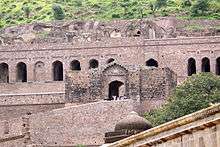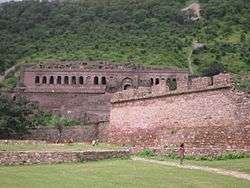Bhangarh Fort
| Bhangarh Fort | |
|---|---|
| भानगढ दुर्ग | |
| Rajasthan, India | |
|
Bhangarh fort | |
 Bhangarh Fort Bhangarh Fort in Rajasthan | |
| Coordinates | 27°5′45″N 76°17′15″E / 27.09583°N 76.28750°ECoordinates: 27°5′45″N 76°17′15″E / 27.09583°N 76.28750°E |
| Type | Fort and Abandoned City |
| Site information | |
| Owner |
Lord Silas (prior) Government of India (current) |
| Open to the public | Yes |
| Condition | Vacant, A Tourist spot |
| Site history | |
| Built | 1613 AD |
| Built by | Madho Singh I |
| Materials | Stones and Bricks |
The Bhangarh Fort (Hindi/Rajasthani: भानगढ़ दुर्ग) is a 17th-century fort built in the Rajasthan state of India.[1] It was built by Man Singh I (one of the navratans of Akbar's court) for his younger brother Madho Singh I. It was named by Madho Singh after his grandfather Man Singh or Bhan Singh.A new village of Bhangarh with a population of 1,306 in 200 households has developed outside the limits of the fort as there is fear of ghosts haunting the old city. The fort and its precincts are well preserved.[2][3]
Geography
The Bhangarh Fort is located on the border of the Sariska Reserve in the Aravali range of hills in Alwar district[4] of Rajasthan.[5] The nearest village is Golakabaas.[2] The fort is situated at the foot of the hills on sloping terrain. The ruins of the King’s palace are located on the lower slopes of the hills; trees surround the pond area and a natural stream falls into the pond within the premises of the palace.[6]
The fort is located 235 kilometres (146 mi) from Delhi and the approach to the entrance gate of the fort in the last 2 kilometres (1.2 mi) stretch of the road is an unpaved road.[5] The fort is 20 miles (32 km) from Thana Ghazi.[6]
Legends

There are two legends narrated to the history of the fort city, which is reported to be haunted, and no one is allowed to remain in the precincts of the fort at night, per a notice board put up by the Archaeological Survey of India at the entrance.[1]
One version of the legend is that a sadhu named Baba Balak Nath lived within the fort area. It was his injunction that any houses built in the precincts of the fort should not be taller than his house, and if the shadow of any such house fell on his house, it would result in destruction of the fort town.[8]
In another version, N.K. SINHAI, the wizard who was adept in black magic fell in love with Ratnavati, the princess of Bhangarh who was very beautiful and had suitors to marry her from many royal families of the country. One day the princess, 18 years of age, went shopping with her friends and was buying Ittar (scent). The wizard saw this and replaced the scent with a love potion in order to ensnare the princess. He offered the potion to her so that she would take a liking to him and marry him.[8][9] However, the princess saw through the wizard's trickery, and when he offered her the bowl of potion, she threw it onto a big boulder nearby. As a result, the boulder started rolling down towards the wizard and crushed him. Before he died, he cursed that Bhangarh would be destroyed soon and no one would be able to live within its precincts. Subsequently, Bhangarh Fort was invaded by the Mughals from the north and the city was surrounded and sacked; 10,000 people lived in the fort city at that time. All the people in the fort, including the princess, were killed. The present state of the fort is attributed to the curse of the wizard and people believe the ghosts in the fort are that of the princess and the wizard. [8][9] Since that day, it is believed that paranormal activities take place here during the night. Some deaths have been reported due to these paranormal activities, too. There are sayings that some of the people's spirit surrounds the boundary of the fort as no one can enter the premises. The princess's spirit has been forcefully abducted by the wizard. Since then, it is believed to be one of the real spooky attractions in Rajasthan.[10]
Features
Entering through the MAIN gate of the completely ruined fort city - now called the "Bhoot Bangla" meaning "House of Ghosts" - gives an eerie feeling that is not proved. Within the fort, at the main entry, one can find temples, palaces and havelis. In addition, there are four more gates of entry to the fort – the Lahori Gate, the Ajmeri Gate, the Phulbari Gate and the Delhi Gate. At the entrance of the main gate, are many Hindu temples such as Hanuman Temple, Gopinath Temple, Someshwar Temple, Keshav Rai Temple, Mangla Devi Temple, Ganesh Temple and Navin Temple.[5] The Gopinath Temple is built above a 14 ft raised plinth and yellow stones are used for the exquisite carvings of the temple.[11] The residence of the priest called the Purohitji Ki Haveli is located in the precincts of the temple complex. Next in order is the Nachan Ki Haveli (dancer's palace) and Jauhari Bazar (market place) followed by the Gopinath Temple. The Royal Palace is located at the extreme end of the fort’s limits.[5]
The temples dedicated to Hanuman and Shiv Mahadev are very elegant but need to be preserved. However, they are built in the style of cenotaphs rather than temples. Jhirri marble has been used in their construction but presently covered by white wash. The Muslim tomb found outside the gate of the fort is reported to be that of one of the sons of King Hari Singh.[6]
References
- 1 2 "Bhangarh Fort, Rajasthan". Zee News. Retrieved 21 July 2013.
- 1 2 Singh 2010, p. 188.
- ↑ "View Population". Office of the Registrar General & Census Commissioner, India. Retrieved 21 July 2013.
- ↑ "Known As The Most Haunted Place In India, Bhangarh Fort Is Not Just Another Place To Visit". Holidify. 2015-05-30. Retrieved 2016-08-12.
- 1 2 3 4 "Bhangarh Fort: The 'most haunted' place in India?". Yahoo News. Retrieved 21 July 2013.
- 1 2 3 Rajputana 1880, pp. 289-90.
- ↑ "The Bhangarh Fort Story". Tripoto. Retrieved 26 February 2016.
- 1 2 3 Stern 2011, p. 7.
- 1 2 "किला जहां सूरज ढलते ही जाग जाती हैं आत्माएं Ravi" (in Hindi). Greynium Information Technologies Pvt. Ltd; Oneindia.in. 11 May 2013. Retrieved 21 July 2013. zero width joiner character in
|title=at position 40 (help) - ↑ "Haunted Places in Rajasthan". Fear And You. Retrieved 11 March 2016.
- ↑ "The Templenet Encyclopedia - Temples of Western India". Gopinath Temple. Temple Net.com. Retrieved 21 July 2013.
Bibliography
- Outlook (2006). 64 Wildlife Holidays in India. Outlook Pub. (India). ISBN 978-81-89449-02-5.
- Rajputana (1880). The Rajputana gazetteers.
- Sarina Singh (15 September 2010). Lonely Planet India. Lonely Planet. ISBN 978-1-74220-347-8.
- Steven L. Stern (1 January 2011). Cursed Grounds. Bearport Publishing. ISBN 978-1-61772-147-2.
